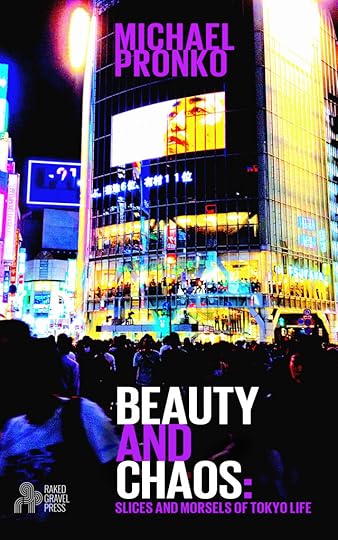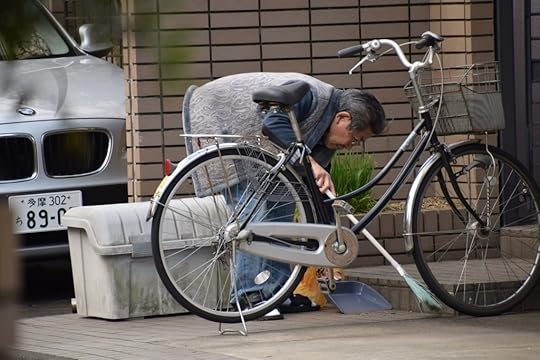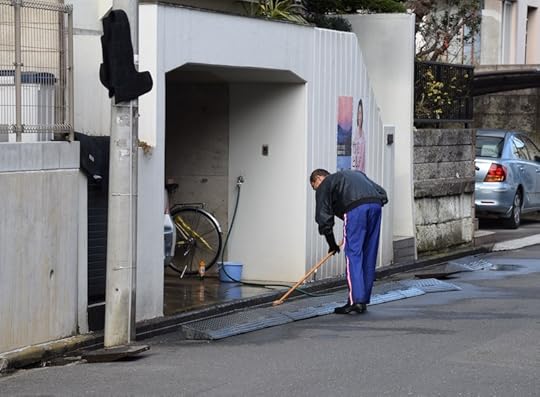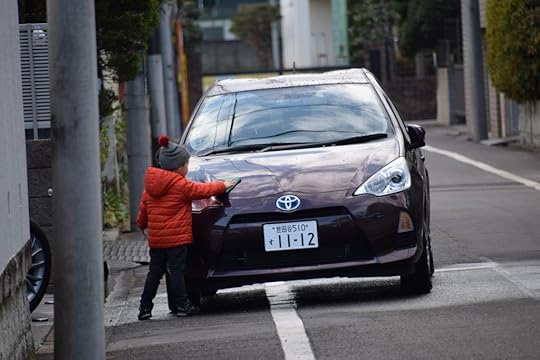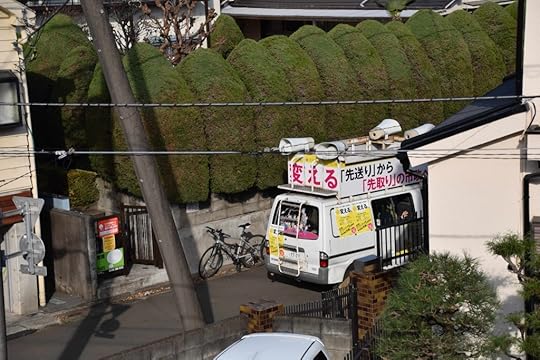Michael Pronko's Blog, page 21
January 18, 2016
Motion and Moments – More Essays on Tokyo
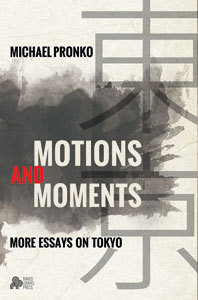
Here goes a nice description of the book, around 100 words will do. Here goes a nice description of the book, around 100 words will do. Here goes a nice description of the book, around 100 words will do.
Here goes a nice description of the book, around 100 words will do. Here goes a nice description of the book, around 100 words will do. Here goes a nice description of the book, around 100 words will do. Here goes a nice description of the book, around 100 words will do.
Here goes a nice description of the book, around 100 words will do.

Tokyo Mystery Deepens – Essays on Tokyo
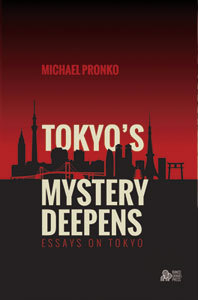
Here goes a nice description of the book, around 100 words will do. Here goes a nice description of the book, around 100 words will do. Here goes a nice description of the book, around 100 words will do.
Here goes a nice description of the book, around 100 words will do. Here goes a nice description of the book, around 100 words will do. Here goes a nice description of the book, around 100 words will do. Here goes a nice description of the book, around 100 words will do.
Here goes a nice description of the book, around 100 words will do.
Beauty and Chaos – Slices and morsels of Tokyo Life
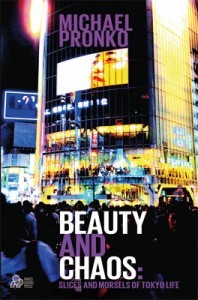
Here goes a nice description of the book, around 100 words will do. Here goes a nice description of the book, around 100 words will do. Here goes a nice description of the book, around 100 words will do.
Here goes a nice description of the book, around 100 words will do. Here goes a nice description of the book, around 100 words will do. Here goes a nice description of the book, around 100 words will do. Here goes a nice description of the book, around 100 words will do.
Here goes a nice description of the book, around 100 words will do.
January 10, 2016
Best Nonfiction of 2015
It’s always great to get positive feedback, but when it comes from a super-cool site that focuses on non-fiction, it’s especially welcome. Doing Dewey is devoted to reviewing non-fiction, and the site covers a lot of amazing books that you might not find elsewhere. Be careful, though, as once you start reading the blog, you’ll start hitting those Add to Cart buttons, too.
Doing Dewey was kind enough to add Beauty and Chaos to their list of the Best Nonfiction Books of 2015!
Doing Dewey’s Review of Beauty and Chaos
January 9, 2016
A Clean Ending
The last day of the year in Tokyo, my neighborhood fills with the hum of machines and the splash of water. The swish of brooms and clink of laundry poles echoes though the air. Everything, inside the houses and out, is getting cleaned. It’s “O-soji,” big cleaning, a ritual of energy and activity that brings the year to a close and leaves everything sparkling clean.
My neighbor across the road was working on his gutters as I stopped to offer my New Year greetings.
“You’re in charge of the outside?” I shout to him, off for my last jog of the year. He looked harried and in need of the last beer of the year.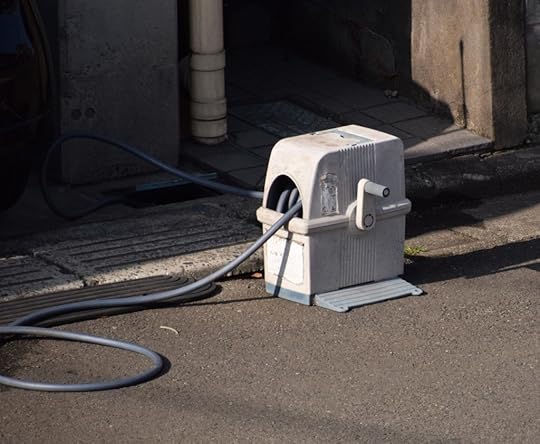
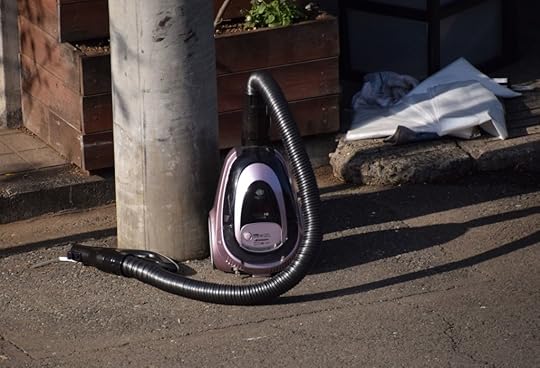
“It’s too, um, busy inside. Safer out here,” he says, nodding at the front door open to air out the interior. The angry whir of a vacuum cleaner comes from inside. “I don’t dare go back in,” he adds, and leans back down to his task.
“Ganbatte! Good luck!” I shout. He has an old vacuum cleaner, a hose, deck brooms and several bags of swept-up leaves, trash and gunk around the perimeter of his home.
I head to the park, guilty for not doing any cleaning whatsoever. All I want is a good, solid jog, which I tell myself is big cleaning of my body, breaking down and pumping out all the toxins from the end-of-the-year parties.
When I get back from the jog in the park, which was relatively clean since the maintenance crews already hauled off the leaves, my other neighbor is out front, sweeping up with the same short broom and pan his father used every morning until he died a few years ago.
“Cleaning up?” I shout to him.
He stands and nods, holding the broom and pan. “It’s the last day of the year,” he tells me, the question left hanging whether I’ve finished my cleaning. I haven’t even started.
The last few days of the year, but especially on the 31st, laundry covers the poles in my neighborhood. Everything washable gets washed. Wet patches spill out over the narrow roads. Every surface, inside and out, gets a wash, wipe or sweep. The thoroughness of it all is obvious even from the outside.
Of course, every culture has its cleaning rituals, spring-cleaning, changing of dishes and cutlery, and ways of keeping the house safe and livable. But I can’t help but feel culture shock thinking of the American end of the year, which is all about partying, or avoiding partying. The need to let loose is paramount in America. But in Japan, the need to rid the surroundings of last year’s dirt carries potent force.
I’m always reminded to clean because the stores all put out front massive displays of cleaning products—bottles, brooms, towels, sponges, buckets of all descriptions and price ranges.
I’m always tempted to buy them and get into it, of course, and in general, I’ve become cleaner and cleaner and more and more orderly over the years in Japan. But I just don’t feel any of the moral, aesthetic or cultural–or just ritual–pressure to get everything spic and span. I like things to be clean, but I don’t feel any shame when they aren’t.
At the end of the year, rather than clean, I want to unwind, review the year, plan for the next, and relish the inner solitude to mull over the passing of time.
But perhaps that’s what everyone in my neighborhood is also thinking while they’re cleaning?
Down the street, cars pulled out of their just-wide-enough parking spots are being given a full wash and wipe. On the other side of Tokyo one shrine offers a special talisman placed on the car for divine protection. Putting that on a dirty car would be an insult to the gods, and probably wouldn’t take effect. Everything must be cleaned for the transition from one year to the next, from one state—dirty, old, used—to the next—clean, refreshed and ready.
The same applies to offices, where the tradition of everyone joining in to clean up the office together is as common as going out for bonenkai or forget-the-year parties. Big cleaning is a sort of forget-the-dirt party, getting rid of the last year’s metaphorical—and actual—dirt so the year can be started clean.
I love this ritual, though at a distance. Even though I don’t join in myself, I still get the benefit.
I feel like everything around me really is cleaner at the start of the year. It’s not just imagined. Storefronts and interiors are spiffed up. My gym’s pool is drained, cleaned and refilled. Cars gleam in the sun. Windows sparkle. The very air of Tokyo feels fresher and purer.
It’s a massive effort to get the entire of Tokyo to its peak of cleanliness. At New Year, for a few days, until the first return to work, the city is cleaner than at any other time of the year.
December 23, 2015
My Third Book is Out!
Motions and Moments: More Essays on Tokyo is now on sale!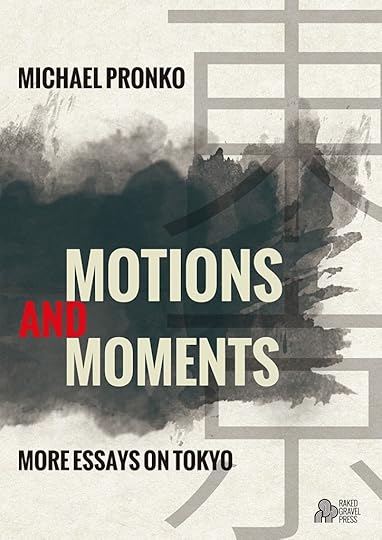
Just in time for Christmas, my third collection of essays is now on sale with greater worldwide distribution than for my last two books. Pick up (by which I mean press an order button) a copy today!
I’m excited about this new book, as it goes even deeper into Tokyo life. The essays reflect on the vagaries and vanities of daily life here and I try to pin down the flow of magical, bizarre instants the city delivers.
In this collection, I include a lot more about what Tokyoites do, eat, and say, and I make some pretty good guesses about what they think and feel, too. I include myself in that category, “Tokyoite,” too, by the way, as the years I’ve lived here roll up to eighteen.
I wrote about the 2011 earthquake, too, in this collection. It was a challenge to find anything good to say, but the triple disaster (earthquake, tsunami and nuclear meltdown) certainly changed–but then again didn’t change–Tokyo life.
Other essays explore sleep, crowds, construction sites, tricky trash, rice balls and how I fail to fit in. I mean, physically, as spaces can be tight. Tokyo manages to wedge in just about everything and everyone, it often seems.
I divided the 42 new essays like this: Surfaces, Miniatures, Constructs, Quaking and Serenities. That covers a lot of territory, but then so does Tokyo.
Links are here:
And don’t forget the first two collections, if you don’t yet have a copy:
Tokyo’s Mystery Deepens: Essays on Tokyo
Beauty and Chaos: Slices and Morsels of Tokyo Life
Happy reading and let’s hope for a new year of peace, prosperity and earthquake-less-ness!
December 18, 2015
Loudness in Tokyo
Just as I was lathering up in the shower, Akiko Murakami came right into the shower. She’s running for mayor, so I wasn’t surprised. Every election season, the same thing happens.
To be honest, she herself was not actually in the steam with me. She was outside, waving from her truck and talking into a microphone connected to rooftop loudspeakers. The sound easily blasted through my walls and into my shower.
And actually, I just made up that name, but it’s always the same for every mayoral candidate. Their voices, at least, all enter my home during every campaign. People in every country might feel there is no escape from politics, but in Tokyo, politics invades your house whether you are showering, reading, snoozing, or having breakfast.
Tokyo’s pre-election season is publicly loud. Trucks with candidates cruise through streets. The candidates and campaign staff inside, all wearing white gloves, repeat—very, very loudly—their names, slogans and pledges to everyone listening, which is everyone, because you can’t escape, even safe at home.
“Do they drive around in trucks in America like that?” my ex-student assistant asked me. “No, they’d get shot,” I answered. But in Japan, most people, lacking guns and interest both, just ignore them. Shutting out loud noises, irritating people, slow-moving crowds, high prices and daily aggravations is a Tokyo skill. Doing that from the comfort of home is even easier.
Because Japan’s neighborhood streets are so narrow, and there is no street-side parking at all, the sound penetrates the thin walls of the houses. In my area, cars have to slow down to pass each other, and have to back up to find a wider space along many of the streets. So, they don’t even have to turn the volume too high; it echoes down the tight-packed rows of homes and small apartments and flows inside.
In front of the train stations, candidates set up flags, hand out leaflets, and stand politely to campaign. Their speeches are not too long, since most people shoot right past them on their way home or to work. They rarely stop to listen, but catch a few minutes of their promises whether they like it or not.
One evening a couple weeks ago, I was surprised to run into one of my former students who lives in my area. He was campaigning in front of the station for one of the mayoral candidates. He stopped me as I hurried past the candidate and his over-amplified speakers. My student told me how he was sick of the old politics and how much he wanted to see change. The campaign felt that much closer, physically personally. It was politics un-mediated, or perhaps de-media-ted.
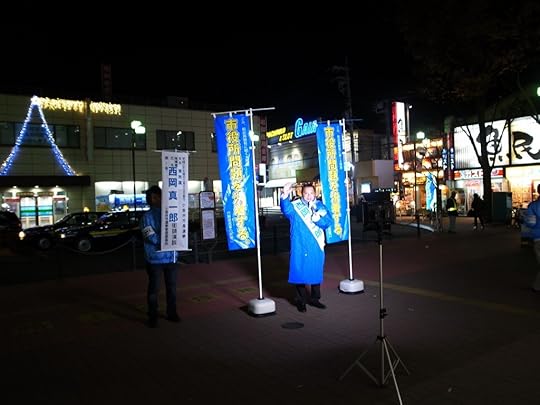 Outside my station,lurking with microphone in hand…
Outside my station,lurking with microphone in hand…
One morning during last year’s election, I was riding my bike to the station and I saw a campaign truck for Naoto Kan, the former Prime Minister. I read his name on the big sign draped over the truck, and thought, “So, he’s got people to do that for him.” But, I was wrong. He was standing right there, on a small bridge over the train tracks. I stopped, startled.
The former Prime Minister, easily recognizable from TV and photographs, and talked fluently about his anti-nuclear stance. As an American, what startled me most was there being only two secret service men around him. The other three campaign staff in bright green jackets might have also been bodyguards, but they handed me a leaflet and chatted with me as he kept on with his loudspeaker speech.
You don’t have to be a potential assassin to realize how safe Japan really is if a former Prime Minister can still stand on the street–actually, on a wide-open footbridge—without any fear. He had chosen a good place to launch his speech into the surrounding living rooms and kitchens of my neighborhood. He was exercising democracy, along with, no doubt, people’s patience.
I told the aide I agreed with shutting down nuclear power plants, and he explained Naoto Kan’s other ideas. No one else had stopped to listen, though I knew they could hear from inside their homes. I advised him that letting foreigners with permanent resident status vote would be a nice democratic move. The aide said he’d pass that on. And I rode off to work.
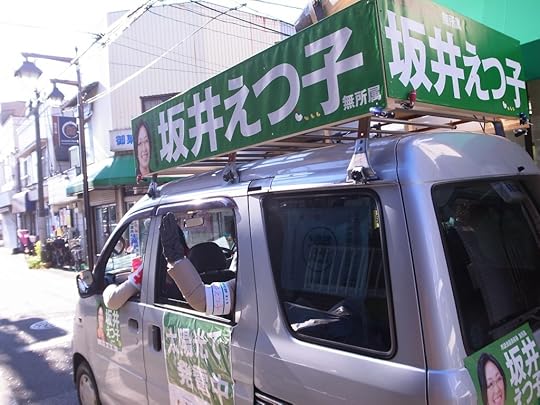 Squeezing by on my bicycle
Squeezing by on my bicycle
I hate the regular campaign noise as much as anyone, but it’s the novelty of campaigning in the streets, the closeness of it and the pleasantness of disruption, that appeals to me. Though I vote only in America, the politics of Japan is close, and even closer during campaign season.
Irritating as it is to be shouted at, and as easy as it is to be cynical, I like being reminded that politics is run by people, who talk and drive and pester voters in loud voices, who are, whether we listen to them or not, always right outside our door.
December 19, 2015
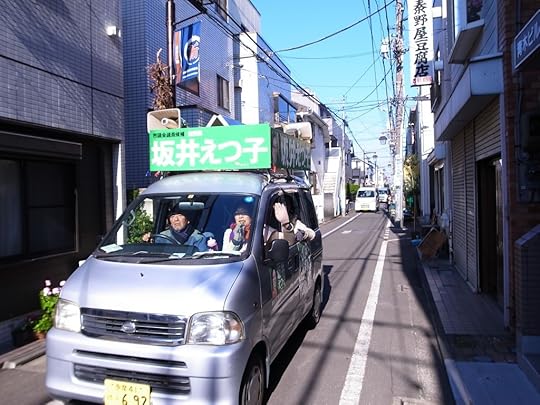 Good luck!
Good luck!
December 11, 2015
Latest book–coming this month! December 2015
Motions and Moments: More Essays on Tokyo
Motions and Moments is my third book on the fluid feel and vibrant confusions of Tokyo life. These 42 new essays burrow into the unique intensities that suffuse the city and ponder what they mean to its millions of inhabitants.
Based on my 18 years living, teaching and writing in Tokyo, these essays on how Tokyoites work, dress, commute, eat and sleep are steeped in insights into the city’s odd structures, intricate pleasures and engaging undertow.
Included are essays on living to size and loving the crowd, on Tokyo’s dizzying uncertainties and daily satisfactions, and on the 2011 earthquake. As in his first two books, this collection captures the ceaseless flow and passing flashes of life in biggest city in the world with gentle humor and rich detail. 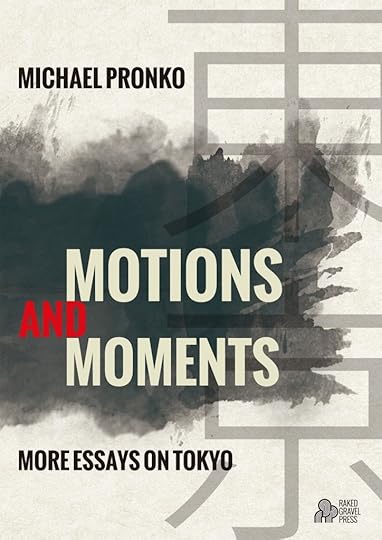
Praise for the first collection, Beauty and Chaos: Slices and Morsels of Tokyo Life:
“A clear-eyed but affectionate portrait of a city that reaches beyond simple stereotypes. An elegantly written, precisely observed portrait of a Japanese city and its culture.” Kirkus Reviews
“Beauty and Chaos is a spectacular read. Its essays are long enough to be cohesive and provocative while remaining short and sweet. The collection is masterful and unique.” Stephanie Chandler, SPR Review
“He notices the kinds of things that might be taken for granted by the Japanese and overlooked entirely by visitors.” Rebecca Foster, The Bookbag
Gold Award First Place for Cultural Non-Fiction (Reader’s Favorite Awards 2015)
Gold Award (Non-Fiction Authors Association 2015)
Praise for the second collection, Tokyo’s Mystery Deepens: Essays on Tokyo:
“As chapters flow through Tokyo cultural experiences, readers receive a rare glimpse of the structure and nature of Tokyo’s underlying psyche. It’s a powerful, intimate consideration of many aspects of Japanese culture.” D. Donovan, Senior Reviewer, Midwest Book Review
“An insider’s view of what life is really like in this pulsing, densely populated Asian metropolis…this little book of short, easy to read essays delivers to its readers an education.” Vera A. Pereskokova Luxury Reading Blog
“Could one have a better guide? Anyone planning to work and live in Tokyo for a period of time will find Pronko indispensable.” BookReview.com
“Tokyo’s Mystery Deepens is so much more than just a guidebook to Tokyo…it actually plunges into the minuscule details of what it is like to be a Tokyoite.” OnlineBookClub.org
Gold Award for Creative Non-Fiction (eLit Awards 2015)
Silver Award for Travel Essay (eLit Award 2015)
September 3, 2015
Gold Prize for Cultural Non-Fiction from Reader’s Favorite
Book Award First Place Gold Prize for Cultural Non-Fiction
For Beauty and Chaos
Annual International Book Award Contest
Review and Prize from Reader’s Favorite
Reader’s Favorite is one of the largest book review and book award sites on the internet!
Awards announced September 1, 2015
August 9, 2015
My Toe in Tokyo
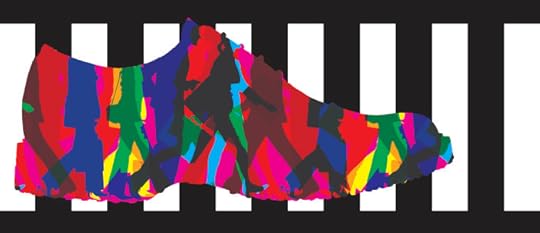 Illustration by Marco Mancini
Illustration by Marco ManciniA few weeks ago, I accidentally smashed my foot against the bookshelf in my hallway at home. My two littlest toes, and then my foot, turned blue, then purple, then green. I iced it, took aspirin and elevated it. It was another end-of-the-semester exhaustion-induced injury, the worst one, it turned out, ever. When I had to proctor final exams a couple days later, my toes still throbbed with pain. So, I taped it up, loosened my shoestrings, doubled the dose of ibuprofen, and headed to work. From that day, my attitude towards Tokyo changed completely.
The great Japanese film director Yasujiro Ozu was famous for looking at the lives of Tokyoites from low-position camera angles, as if watching events while sitting down on the tatami. My new point of view on Tokyo went even lower, right down to the ground. From the point of view of my little toes in great pain, Tokyo became a different city altogether.
First, I noticed the ground. Tokyo is not a flush, level city. The city is a mish-mash of uneven sidewalks, irregular stairs, and slippery floors. Each provided a different type of pedal agony. I became aware of every little bump. Even the yellow bumpy pathways for blind people made the bruised bones in my foot contort with pain. American cities are designed to accommodate the automobile, but Tokyo is designed around human feet!
And there are a lot of feet in Tokyo, all of them suddenly threatening. I realized any one of thousands of other feet could bump my tender toe. I kept edging away from people, desperate to leave some space between them and my second smallest right toe, the one that really hurt. Women in high heels no longer seemed so sexy, but like foot-stomping menaces, their heels like threatening little kendo sticks. I kept looking down, checking the proximity of their feet to mine and the toughness of the leather of their shoes.
As if to really test me, one day the Chuo Line trains were late. Typically, that means the next train becomes doubly loaded, and the next triply, and so on, depending on how many trains late things run. But with my toe in pain, that meant triple the danger. So, instead of plunging in as usual, I waited. But the next two trains were also packed, and I knew the rest would be, too, so I decided to risk it.
Usually, when I get on a super-crowded train, I grab a handhold over eh door, plant both feet and back-push on. But this time, with only one good pushing foot, I was unmanned. I had to wiggle weakly into place, hopping slightly and twisting clumsily.
But then, as the doors closed, it dawned on me, I could lift my sore foot up from the floor safely, like a flamingo, and the surrounding pressure of everyone around me would hold me securely in place. For once, I was thankful of the crowd.
That week, I tried not to limp too obviously when a pretty girl walked by, but the rest of the time, I clung to handrails like a drunken man. I took wide berths to see around corners, kept my right foot out of traffic, and searched ahead for escalators and elevators. I could no longer deftly avoid oncoming people, since I couldn’t pivot on my right foot. Instead of neatly swerving while maintaining my pace, I had to stop from time to time to let someone pass.
I had long since learned the Tokyo skill of moving like a school of fish; but suddenly, I was no longer part of the flow, but an un-Tokyo-like obstacle! Me, the perfectly trained commuter! All my hard-won crowd motion skills were for naught. Lurching through the crowds like Frankenstein, I grasped fully just how much wear and tear Tokyo puts on the 26 bones of the human foot.
I understand now why Tokyo has more shoe stores than any other kind! Finding the right shoes means being able to negotiate the city in the way you want. Not having the right shoes means you are not able to live as you like. In Tokyo, “I walk, therefore I am.”
After slowing down, I noticed an entirely new city—a slow-paced one. I saw older people ambling through places where I used to zip along. I saw people strolling, in no hurry whatsoever, looking around. I never before noticed all the people who plan their day around less crowded trains, like the 11:32 express I discovered I could get a seat on! I joined a new Tokyo group—the non-rushers.
There were lots of Tokyoites who were not in a big hurry, who didn’t clinch their buttocks and surge every forward. Plenty of people ambled calmly, almost sweetly. I just had never seen them before. The slow-paced Tokyo had been hidden from my view because I was always going way too fast.
Now that my foot is recovered, more or less, I’m not so sure I want to go back to high speed Tokyo. I kind of like the slower pace. I can see the city differently, and feel it much more deeply, even if, from time to time, depending on how I step, I still feel it a bit painfully.
Click on the link below to download the essay in PDF format.



